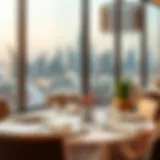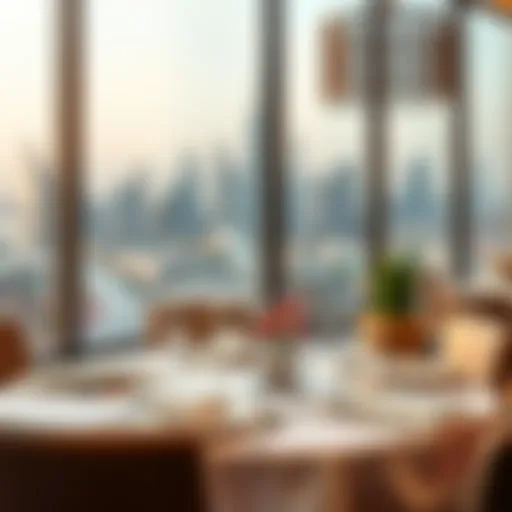Discover the Most Stunning Spots in Dubai
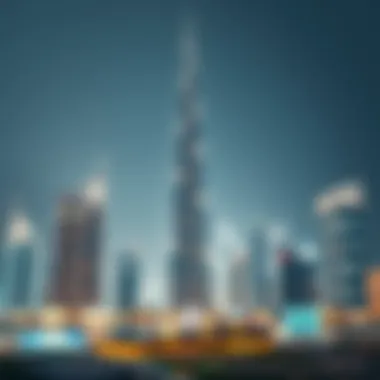
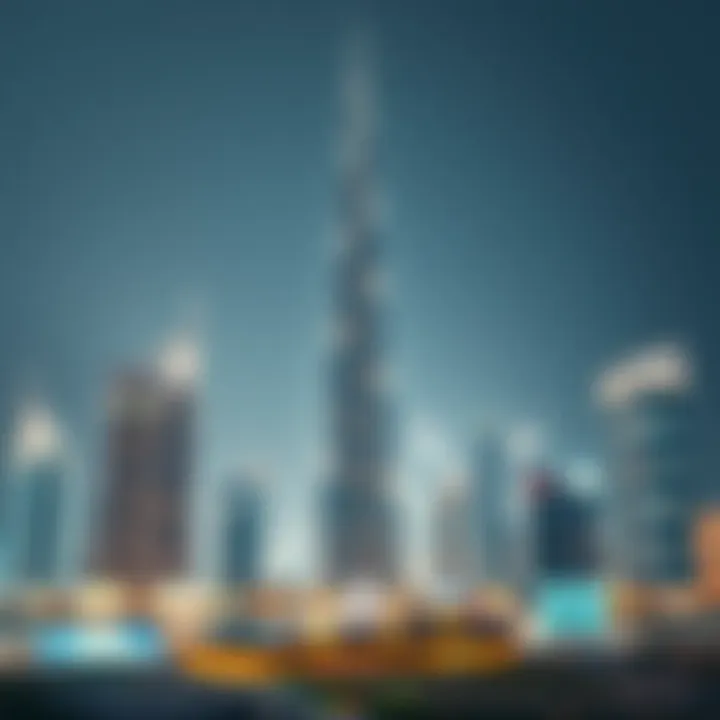
Intro
Dubai is a city that seems to blend dreams and reality. Its skyline is punctured by astonishing architectural feats that shine brightly against the desert backdrop. Each corner of this city tells a different story, showcasing its rich heritage and modern ambitions. From opulent shopping malls to stunning waterfronts, Dubai offers a diverse palette of beauty that attracts millions of visitors each year.
At the heart of this allure lies its vast potential for real estate investment. The city’s rapid development has created an intricate tapestry of neighborhoods, each with unique charm and significance. Understanding these areas not only enriches the experience of exploring Dubai's landscapes but also offers insight into the flourishing real estate market.
This journey not only focuses on the visual splendor but also peels back layers of investment opportunities and market trends. The location’s appeal goes beyond the eye; it holds the promise of lucrative returns for investors and an enviable lifestyle for homeowners. As we delve deeper into the most beautiful places in Dubai, expect to uncover the essential components that define this city's vibrant environment, all while considering their influence on property values and investment potential.
Dubai's Architectural Splendor
Dubai's skyline is a striking blend of contemporary innovation and traditional flair. When one thinks of Dubai, phrases like "architecture like no other" and "the jewel of the desert" come to mind. This section is pivotal as it not only showcases the aesthetic appeal of these structures but also emphasizes their role in shaping Dubai's identity and economy. The architectural designs reflect a unique blend of culture, ambition, and the relentless spirit of advancement. Investors often see these architectural marvels as value enhancers when considering property investments in their vicinity.
Burj Khalifa: The Pinnacle of Modern Design
Standing tall at 828 meters, the Burj Khalifa is an iconic representation of what modern architecture can achieve. This towering structure is not only tall; it's an engineering masterpiece, crafted using cutting-edge technology and materials. The design, inspired by traditional Islamic architecture, offers both functionality and beauty. Visitors can ascend to observation decks for panoramic views, providing a breathtaking perspective of the city layout and desert expanse beyond.
Investors have recognized the Burj Khalifa's influence on surrounding property values. High-end real estate nearby ensures stakes rise, with locales becoming hotspots for luxurious living. The juxtaposition of this skyscraper with the sprawling city below creates a visually captivating experience, making it a must-visit for tourists and a symbol of pride for locals.
The Palm Jumeirah: A Testament to Human Ingenuity
The Palm Jumeirah, often described as a miracle of modern engineering, is shaped like a palm tree lined with luxurious villas and hotels. This man-made island exemplifies Dubai's ambitious spirit and is a striking example of how human creativity can reshape landscapes. Each frond of the palm represents a different residential area, making it an exclusive enclave for some of the world's wealthiest individuals.
Beyond aesthetics, the Palm also has a practical role. It serves as a central point for tourism with upscale resorts and vibrant beach life. This unique feature draws visitors from all corners, substantially impacting local economies and encouraging investment. Properties along the Palm are always in demand, making it a promising area for real estate investors looking for long-term gains.
Dubai Frame: Bridging the Past and Present
The Dubai Frame is a more recent addition to the city's architectural palette, brilliantly symbolizing a connection between Dubai's rich history and its modern aspirations. At its core, the frame consists of two high rises connected by a glass bridge, allowing visitors to appreciate both the old and new cityscapes. Those who ascend to the bridge can gaze over historical sites like the Al Fahidi neighborhood and gleaming new buildings, presenting a juxtaposition that is as educational as it is visually stunning.
This site serves not just as a tourist attraction but as a lesson in the city’s evolution. The real estate in the vicinity benefits from increased foot traffic and visibility, encouraging investment from developers looking to manage and harness the tourist influx. Dubai Frame perfectly illustrates the city’s commitment to marrying tradition with modernity, a consideration that investors should keep in mind when looking at property opportunities in the area.
Natural Wonders of Dubai
The natural wonders of Dubai provide a refreshing contrast to the urban landscape characterized by gleaming skyscrapers and bustling markets. This section delves into the vital role these natural elements play, offering serene alternatives to the fast-paced lifestyle many experience in the city. They not only draw tourists seeking respite but also serve as significant factors for property investors looking to capitalize on unique views and recreational offerings.
The Desert: An Expansive Serenity
The desert surrounding Dubai is more than just a vast sea of sand; it harbors an enchanting calmness that captivates the soul. Every grain tells stories of ancient civilizations, and the shifting dunes create a mesmerizing tapestry under the sun. Visitors often find that moments spent amidst these tranquil sands lead to a deeper connection with the land.
Engaging in activities like dune bashing or taking a hot air balloon ride reveals the breathtaking beauty of the sunrise over the dunes—a sight that is hard to put into words. The vast expanse offers investors a unique angle; properties that provide access to desert experiences are increasingly sought after, appealing to those looking for adventure and tranquility.
Dubai Creek: The City’s Lifeblood
Dubai Creek is often referred to as the lifeblood of the city, intertwining the modern and the traditional. Historically, it served as a crucial trade route, allowing the flow of goods and culture that helped shape Dubai into the metropolis it is today. Strolling along the creek, one can witness a blend of old-world charm and contemporary developments.
The waterway acts as a conduit for water taxis, allowing easy access to various neighborhoods. Property developers recognize the creek’s importance, often designing luxury residences that present stunning waterfront views and proximity to vibrant souks and cultural landmarks. This blend of lifestyle and culture enriches the real estate landscape and enhances value, making it an attractive investment opportunity.
Al Qudra Lakes: An Oasis in the Desert
Al Qudra Lakes stand as an unexpected haven, created by humans yet harmoniously integrated into the arid surroundings. This project showcases how innovative thinking can yield beautiful results, offering habitats for wildlife and a recreational spot for residents. Birdwatchers and picnickers flock to this oasis, enjoying the scenic views and tranquil atmosphere.
From an investment perspective, locations near Al Qudra are becoming hotspots for those who appreciate nature and outdoor activities. The serene lakes provide a backdrop that is increasingly appealing, especially for families looking for a slice of nature amidst Dubai’s expansive urban growth. The growing interest in eco-tourism further underscores the potential of properties near these lakes, signaling a healthy market for savvy buyers.
Cultural Sites and Historical Wonders
Cultural sites and historical wonders play a critical role in shaping the identity of Dubai. As the city continues to flourish as a modern metropolis, it’s easy to overlook its rich cultural heritage. These sites celebrate the journey from a humble fishing village to an ultra-modern city, allowing investors and visitors alike to grasp the nuances of Dubai’s evolution. For those captivated by architecture, history, or cultural experiences, these locations provide invaluable insights into the traditions that underpin the Emirati way of life.
The preservation and promotion of these historical sites serve not only as a source of pride but also as a bridge connecting residents and tourists to their roots. Moreover, they often positively impact property values in their vicinity, enhancing the appeal of nearby real estate. In essence, visiting these attractions allows one to appreciate the city’s multifaceted identity while offering opportunities for thoughtful investment in the surrounding neighborhoods.
The Al Fahidi Historical Neighborhood: A Glimpse into the Past
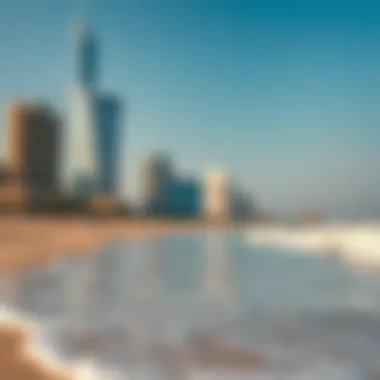
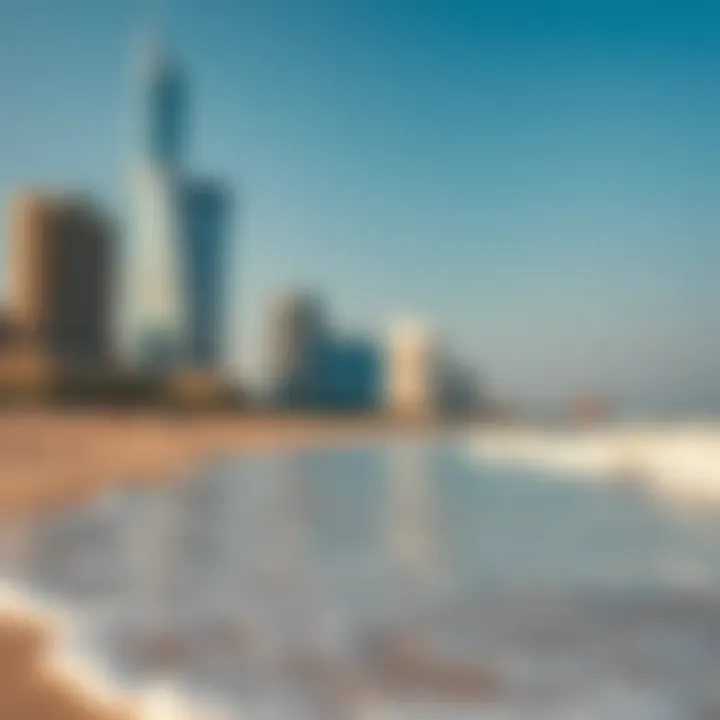
The Al Fahidi Historical Neighborhood, also known as Al Bastakiya, stands as a living museum within the bustling heart of modern Dubai. With its narrow winding alleyways and wind-tower architecture, this area harkens back to the late 19th century when it was primarily inhabited by Persian merchants. Its myriad art galleries, cafes, and cultural spaces breathe life into the district while giving a glimpse into the region’s past.
Visitors can discover traditional Arabian architecture, characterized by coral stone walls and intricate wooden details. As you stroll through the streets, you might stumble upon the Sheikh Mohammed Centre for Cultural Understanding, which offers an opportunity to engage in discussions about Emirati customs and heritage. Here, the slogan “Open Doors, Open Minds” reflects a commitment to fostering intercultural understanding.
Engaging in a guided tour can provide deep insights into daily life in historical Dubai, showcasing the stark contrasts between the past and present. This blend of history and culture makes Al Fahidi a must-visit for those seeking to understand the soul of the city.
Dubai Museum: A Chronology of Tradition
Located within the captivating Al Fahidi Fort, the Dubai Museum serves as the city’s primary historical repository. The museum offers a chronological narrative chronicling the evolution of Dubai, from its early days as a pearl diving center to an international business hub. Within the museum’s walls, carefully curated exhibits include artifacts, multimedia presentations, and dioramas that depict traditional Emirati life.
One particularly engaging area resembles a traditional souk, filled with spices, textiles, and handicrafts. These immersive experiences transport visitors back in time, effectively illustrating the daily lives and livelihoods of the region’s past inhabitants. The museum not only preserves these traditions but actively engages a new generation in understanding their importance.
For investors, it’s essential to recognize the intrinsic value that cultural institutions like the Dubai Museum add to real estate investments. Properties located near museums and cultural centers often enjoy higher demand and sustained interest.
Jumeirah Mosque: Architectural Elegance
Jumeirah Mosque is a stunning example of modern Islamic architecture, hailed for its breathtaking design and harmonious proportions. Built in the mid-1970s, it is one of the few mosques in Dubai open to non-Muslim visitors. The mosque’s white stone façade glows against the backdrop of a clear blue sky, making it a striking feature of the Dubai skyline.
Guided tours provide an opportunity to learn about Islamic culture, allowing visitors to engage with local customs and traditions respectfully. The warmth of the Emirati welcome leaves a lasting impression on all those who step within its engaging walls. Visitors often leave with a newfound respect for the values of openness and inclusion that the mosque represents, reinforcing the fundamental principles of community and compassion inherent in Islamic teachings.
For stakeholders in the real estate market, proximity to significant cultural landmarks such as Jumeirah Mosque heightens the allure of residential properties. The mosque stands not only as a source of spiritual solace but also as a pivotal landmark, contributing to the vibrancy of the community surrounding it.
Engaging with cultural sites nurtures interconnectedness and inspires appreciation of diversity among residents and tourists, further enhancing the property’s value in affluent areas.
Urban Gardens and Parks
Urban gardens and parks serve as vital lungs of Dubai, injecting vitality into the concrete canvas of this bustling city. These green spaces offer a retreat from the hustle and bustle, allowing residents and visitors alike to connect with nature, engaging the senses in a way that the modern architectural marvels cannot. Not only do these parks provide recreational areas, but they also have tangible benefits on mental well-being and community interaction, making them significant landmarks in the urban landscape.
In a city that prides itself on its luxury and opulence, the inclusion of natural parks and gardens is a testimony to the balance Dubai seeks to maintain between development and preservation of the environment. As places where flora flourishes and families bond, they play a crucial role in improving property appeal and increasing surrounding property values.
Dubai Miracle Garden: Nature's Vibrant Canvas
Dubai Miracle Garden stands as a dazzling oasis bursting with over 150 million flowers, creating one of the largest natural flower gardens worldwide. This unique botanical showcase, typically open from November to April, features intricate designs and breathtaking installations, including floral archways and sculptures like the iconic Emirates Airbus A380 crafted entirely out of flowers.
The experience of walking through this garden is like stepping into a painting, where colors bloom and fragrances envelop you. It attracts not just tourists, but also numerous investors and realtors keen to showcase this beauty to potential homebuyers looking for a place surrounded by greenery.
The success of this park isn’t just in its beauty; it also rejuvenates interest in nearby real estate developments, as properties that gazes upon such a vibrant space often see their value spiked.
Zabeel Park: A Green Retreat Amidst Urbanity
Zabeel Park is another gem, offering a serene escape right in the heart of Dubai's bustling cityscape. This park, which spans over 120 hectares, features vast lawns, barbecue areas, and playgrounds, making it perfect for family picnics or leisurely strolls amid lush greenery.
The park is also home to the Dubai Frame, a popular tourist attraction. The presence of such landmarks enhances the park's reputation, boosting its desirability among real estate buyers who look for properties near recreational spaces. Residents enjoy not just spaciousness, but also the kind of lifestyle amenities that attract expatriates looking for community vibes, emphasizing how investing in properties nearby can yield long-term benefits.
Additionally, Zabeel Park holds various events and festivals throughout the year, promoting community engagement and enhancing the cultural fabric of the area, further increasing its importance in the urban context.
Safa Park: A Hub for Leisure and Recreation
Safa Park is positioned as a focal point for leisure seekers and fitness aficionados alike. With an array of walking and jogging trails framed by stunning flower beds and shaded trees, it’s a popular haunt for those looking to unwind or get their daily exercise.
One of the distinctive features of Safa Park is its central location, offering panoramic views of the Dubai skyline. This picturesque setting makes it a lucrative prospect for property developers aiming to attract buyers who appreciate both nature and modern living. Homes in proximity to such parks are frequently positioned as highly desirable, with potential buyers willing to pay a premium just for the access to recreational areas.
To sum up, the rich tapestry of urban gardens and parks in Dubai does more than just beautify the landscape; they improve the quality of life for residents and stand to significantly impact property desirability in their vicinity. As such, understanding the relationship between these green spaces and the real estate market is crucial for investors and homeowners alike.
"Green spaces are not just a luxury; they are an essential component of urban living that fosters community and enhances property value."
For further insights into Dubai's urban development and planning, you might find helpful resources at Dubai Municipality or Dubai Property Group.
Shopping and Leisure Destinations
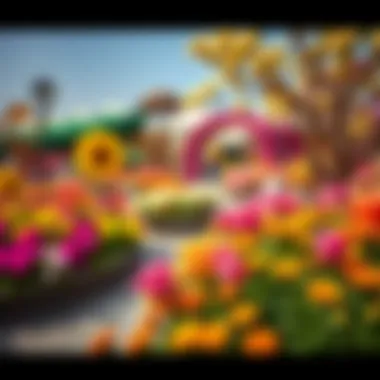
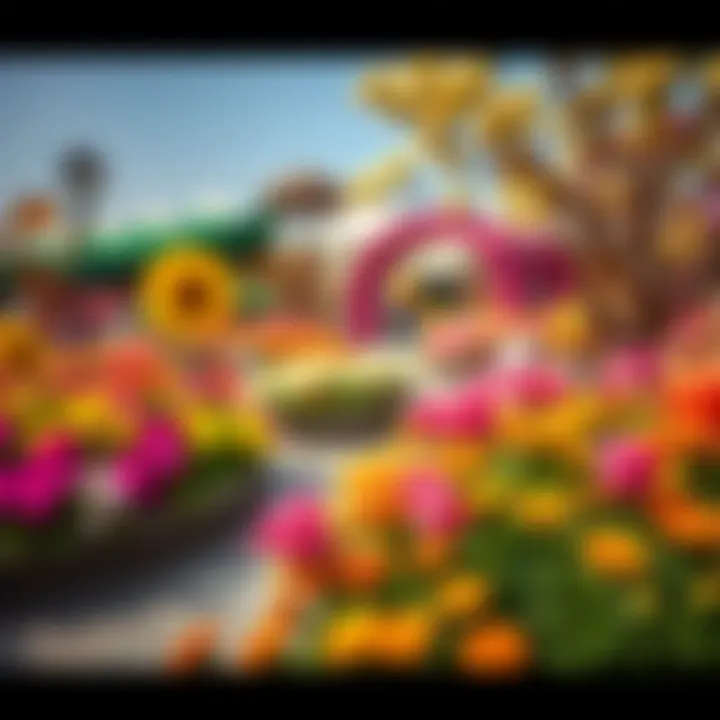
When it comes to exploring Dubai, shopping and leisure destinations play a pivotal role in showcasing the city’s blend of culture, modernity, and luxury. The shopping experiences here are not merely about buying goods; they serve as a vibrant backdrop that encapsulates the spirit of Dubai. From traditional souks to extravagant malls, each destination highlights the diverse offerings that cater to both residents and tourists alike.
The significance of these areas extends beyond retail; they act as social hubs where individuals can gather, eat, and partake in various activities. Visiting these locations can be an adventure on its own, with different atmospheres to indulge in. It’s crucial for investors and business owners to understand these dynamics, as the popularity of these destinations has a direct impact on real estate values. The commercial spaces situated nearby often see a substantial increase in demand, reflecting their importance not just as shopping venues but as integral parts of Dubai’s economic identity.
The Dubai Mall: A Shopper's Paradise
As the crown jewel of Dubai shopping, The Dubai Mall is not just a place to shop; it's a whole world in itself. Spanning over 1.1 million square meters, it’s hard to overlook its grand scale. The mall houses more than 1,200 retail outlets, ranging from high-end brands to popular fast-fashion retailers.
Notable features of The Dubai Mall include:
- Aquarium and Underwater Zoo: A sight that leaves many visitors in awe, this massive tank holds thousands of aquatic animals, making it a must-see.
- Ice Rink: For those feeling adventurous, the Olympic-sized ice rink offers a unique way to beat the heat.
- At The Top, Burj Khalifa: Providing breathtaking views of the city, this observation deck is a popular draw for tourists.
For homebuyers and investors, proximity to The Dubai Mall can significantly enhance property value. It’s an area that consistently attracts foot traffic, thereby increasing the likelihood of successful retail investments.
Mall of the Emirates: Beyond the Retail Experience
The Mall of the Emirates goes beyond being a shopping arena; it's an all-encompassing leisure destination. Home to over 600 retail stores, this mall also features Ski Dubai, an indoor ski resort which is quite a rarity in this region.
Highlights that set Mall of the Emirates apart include:
- Ski Dubai: One of the world’s largest indoor ski resorts, featuring real snow and various slopes for all skill levels.
- VOX Cinemas: Offering a plush cinema experience with the latest films, it’s perfect for family outings.
- Dining Options: From gourmet restaurants to casual eateries, the food scene is vibrant, catering to every palate.
For investors, the Mall of the Emirates signifies a golden opportunity. Its diverse offerings attract a wide demographic, ensuring that surrounding properties maintain their value. With leisure elements integrated into the shopping experience, it creates a community-focused environment.
Souk Madinat Jumeirah: Cultural Shopping Experience
For a taste of traditional Arabian hospitality combined with modern conveniences, the Souk Madinat Jumeirah is a hidden gem. This marketplace features winding alleyways filled with shops that reflect the local culture. Unlike the vast malls, its intimate setting offers a unique charm.
Key characteristics of Souk Madinat Jumeirah include:
- Artisan Shops: Visitors can find handcrafted goods that embody the spirit of the Middle East, from jewelry to textiles.
- Waterways: The picturesque canals provide a sense of serenity, with abra rides offering a tranquil viewing experience of the surroundings.
- Dining Experience: Numerous restaurants with stunning views of the Burj Al Arab make dining here an experience to remember.
For renters and homebuyers, properties near this souk not only offer access to a unique cultural experience but also stand to benefit from the ongoing popularity of the space. Its connection to both history and modernity makes it an attractive option for those looking at real estate investments.
By understanding these locations, one can appreciate their role in shaping a diverse and engaging community.
Vibrant Nightlife and Scenic Views
Dubai’s nightlife stands out as a dazzling fusion of various cultures and experiences. The vibrant scenes after sunset create a magnetic pull, ensuring that visitors and residents alike are captivated by a variety of engaging options. From chic lounges to lively pubs, the city's nightlife is a key element that enriches its urban aesthetic. Scenic views accentuate these experiences, as patrons enjoy breathtaking sights, some of which showcase architectural masterpieces illuminated against the night sky.
Here, we delve into three key venues that exemplify the marriage between scenic views and lively entertainment. Each offers its own unique flair, making them essential stops for anyone looking to understand the diverse landscape of Dubai’s nightlife.
Rooftop Bars: Elevated Perspectives
Rooftop bars in Dubai often serve as a symbol of luxury and sophistication. These elevated venues provide stunning panoramas of the Dubai skyline, particularly during sunset when the sky is painted in hues of orange and pink. Bar 44, located in the Al Qasr Hotel, is one such place where patrons can sip signature cocktails while gazing at the magnificent Burj Al Arab. The experience is heightened by the soft music playing in the background, which adds to the relaxed atmosphere.
The allure of rooftop bars extends beyond just the drinks. The thrill of socializing at a high altitude, coupled with the city’s twinkling lights below, creates memorable experiences for both locals and tourists. Here’s why they are worth exploring:
- Unparalleled Views: Each rooftop bar offers unique perspectives of the city.
- Sophisticated Decor: Often styled with modern furnishings, they provide an upscale ambiance.
- Diverse Menus: From artisanal appetizers to creative cocktails, there's something to please every palate.
Dubai Marina: A Nighttime Waterfront Experience
Dubai Marina transforms into a spectacular setting once the sun dips below the horizon. This waterfront district buzzes with life, as both residents and tourists flock to the numerous restaurants and cafes lining the marina. Illuminated yachts drift softly on the water while lively music fills the air.
Walking along the promenade, visitors are treated to a myriad of sights, including the shimmering waters reflecting the high-rises that line the coast. The iconic Pier 7 hosts a collection of diverse dining options, offering everything from Asian fusion to authentic Italian cuisine. This variety makes Dubai Marina an ideal spot for a culinary adventure paired with stunning views.
Some highlights of visiting Dubai Marina at night include:
- Craving Waterfront Dining: Many restaurants offer outdoor seating with spectacular views.
- Illuminated Jetties: They create a magical atmosphere as boats come and go, forming a lively backdrop.
- Night Markets: Customers can explore artisanal crafts, local goods, and delectable street food.
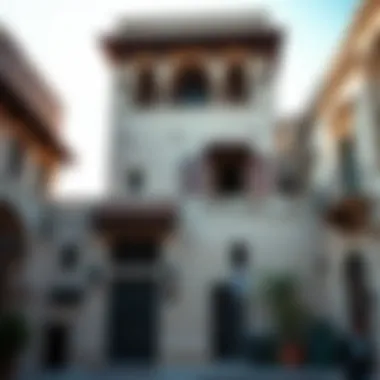
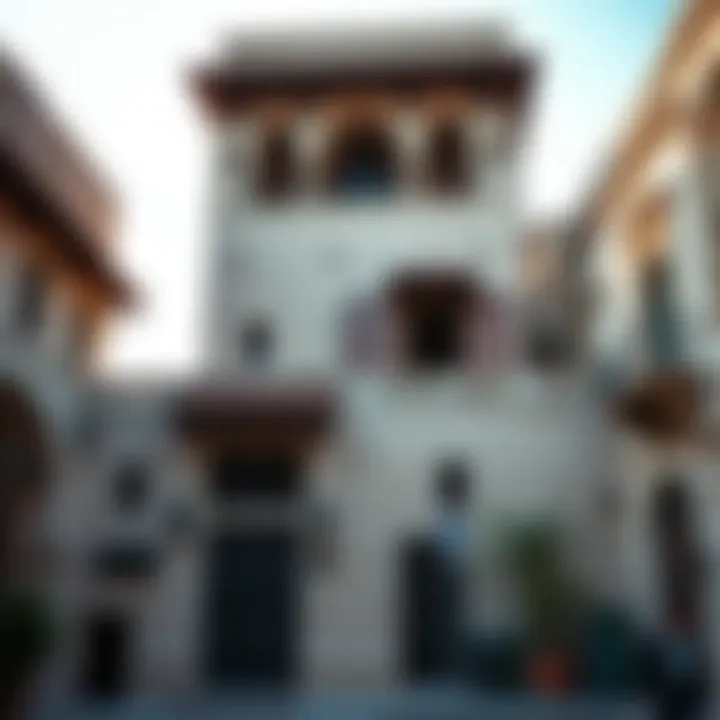
The Dubai Fountain: A Dazzling Performance
No exploration of Dubai’s vibrant nightlife would be complete without mentioning the Dubai Fountain. Nestled at the base of the Burj Khalifa, this spectacular water show is choreographed to music and lights that create a mesmerizing display. As the lights dance and water jets soar high, onlookers gather to take in the captivating performance.
Show times typically occur in the evening, and a prime viewing spot can often be found at the Dubai Mall, where visitors can pair shopping with the show. The atmosphere buzzes with excitement as crowds gather, reinforcing the allure of this vibrant locale.
Key Features of The Dubai Fountain Include:
- Size: It stretches over 900 feet long, making it one of the largest fountains in the world.
- Choreography: Each performance is tailored to different music genres, from classical to contemporary hits.
- Fire and Light: Certain shows even incorporate fire elements, enhancing the visual impact.
"The vibrancy of Dubai's nightlife, with its emphasis on stunning views and unique experiences, is essential to understanding the city's culture and allure."
In summary, the nightlife in Dubai is more than just about partying; it is an opportunity for social connection and breathtaking experiences against a stunning backdrop. The beauty of the city truly shines when the sun goes down, showcasing why scenic views and vibrant nightlife are core aspects of Dubai's identity.
The Role of Aesthetics in Real Estate
In Dubai, the relationship between aesthetics and real estate is a crucial one that holds significant sway over market dynamics. This vibrant city is renowned not only for its architectural marvels but also for the inherent beauty that influences both local residents and international investors alike. Aesthetic appeal encompasses various elements, from exceptional design and landscaping to cultural resonance, each playing a vital role in dictating property value and desirability.
Impact on Property Values
The interplay between a property’s aesthetics and its market value is more than just a surface-level consideration. Buyers, whether they are individuals seeking a home or investors looking to capitalize on rental opportunities, tend to favor properties that exhibit a coherent and impressive design. When neighborhoods are visually appealing, comprising interesting architecture and well-maintained parks or communal spaces, they experience a direct positive impact on property values.
- First Impressions Matter: The initial visual impact can be a deal-maker or breaker. A well-presented property attracts attention and stimulates interest, leading to potentially higher offers.
- Emotional Connection: Buyers often form an immediate emotional bond with visually striking properties. It’s not just about brick and mortar; it’s about the feeling a home provides.
- Consistency in Design: Developments that maintain a cohesive design aesthetic can enhance the overall value of the area. Such neighborhoods tend to elevate their brand as desirable places to live or invest.
As such, aesthetics present genuine opportunities for value appreciation within Dubai’s competitive market.
Investor Attention: Analyzing Trends
Investors are increasingly drawn to aesthetically pleasing developments, which correlate with positive market trends. These developments not only promise potential monetary returns but also attract residents, which, in turn, boosts local economies. By understanding the significance of aesthetics in real estate, investors can make informed decisions that align with current market demands.
Emerging Trends
- Luxury Living: Properties that offer extraordinary aesthetics attract affluent buyers willing to pay a premium. Architectural uniqueness, for instance, can be a major selling point.
- Sustainable Design: Eco-friendly features and sustainable materials are gaining traction. Such properties not only showcase beauty but also appeal to the ethical considerations of many investors.
- Cultural Integration: Developments that reflect local heritage and culture resonate deeply with potential buyers, making them more desirable.
In an ever-evolving marketplace, investors who remain attuned to aesthetic trends position themselves for success.
Tourism as a Revenue Stream
Aesthetics also play a pivotal role in bolstering Dubai’s tourism sector, which significantly feeds into its real estate market. Properties that offer breathtaking views or showcase unique architectural traits serve as attractions in their own right.
How Aesthetics Attract Tourists
- Iconic Landmarks: The Burj Khalifa and Palm Jumeirah aren’t just places to see; they are experiences that draw millions of visitors annually. Each visit increases interest in nearby real estate offerings.
- Cultural Attractions: Aesthetically rich neighborhoods, like the Al Fahidi Historical Neighborhood, help position Dubai as a cultural hub, encouraging longer stays and, hence, increased rentals or sales in those areas.
- Luxury Hospitality: Upscale hotels and resorts, designed with aesthetic excellence, indirectly promote local real estate as travelers often consider purchasing property in places they enjoy visiting.
The synergy between aesthetics and tourism in Dubai not only enhances the city’s appeal but also creates a ripple effect in the local real estate market, addressing both investors' and residents' aspirations.
By understanding these relationships, stakeholders in Dubai’s real estate market can navigate the complexities of property investment while appreciating the beauty that this unique city has to offer.
Culmination: The Essence of Dubai's Beauty
In the grand narrative of Dubai, the beauty resonating from its landscapes isn’t just a visual experience; it encapsulates the heart and soul of a city that harmonizes tradition with modernity. This article’s exploration sheds light on the visually arresting places that symbolize Dubai’s rapid development and cultural richness. The blend of architectural marvels and natural wonders offers a vital understanding of how aesthetics and culture drive both tourism and real estate.
Summarizing Key Attractions
Dubai presents a medley of attractions that stand testament to the city's diverse appeal. Each landmark tells a different story, weaving together threads of tradition and innovation.
- Burj Khalifa: An iconic symbol that reaches for the stars, it’s not just the tallest building, but an experience that showcases the spirit of Dubai.
- Dubai Miracle Garden: A riot of colors and patterns, this garden is a seasonal attraction that captivates visitors with its floral displays, making it a keeper of nature’s beauty.
- Al Fahidi Historical Neighborhood: This neighborhood presents a sharp contrast to the glass-and-steel skyline, allowing a glimpse into Dubai's historical roots that inform its contemporary culture.
Through such attractions, the emirate emphasizes its commitment to providing immersive experiences that attract millions of visitors yearly. Not only do these sites elevate the city’s status on the global stage, but they also boost local property values and investment potential, influencing both real estate trends and tourism.
Looking Forward: Future Developments
As Dubai continues to evolve, the future holds promise for even more breathtaking developments. Several key projects set to transform the landscape are already in the pipeline:
- Dubai Creek Harbour: A burgeoning area that aims to blend urban living with serene waterfront experiences—this project is poised to redefine luxury living.
- Expo 2020: Though initially postponed, this global event serves as a catalyst for new opportunities and infrastructures that engender tourism and cultural exchange.
- Sustainable Initiatives: Dubai's push toward sustainability could bring new parks, eco-friendly buildings, and community spaces that enhance quality of life while preserving natural beauty.
Watching how these developments unfold is not just captivating for tourists, but crucial for investors looking to tap into potential growth areas. The balance of preserving Dubai’s unique identity, while embracing world-class innovations, is central to its ongoing narrative.
